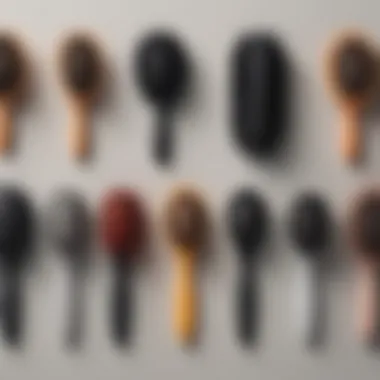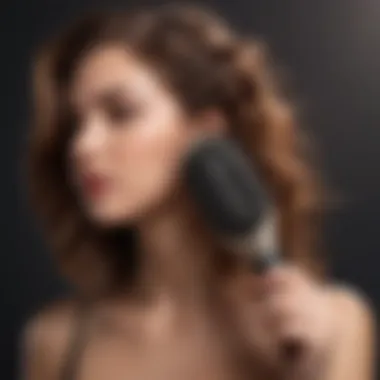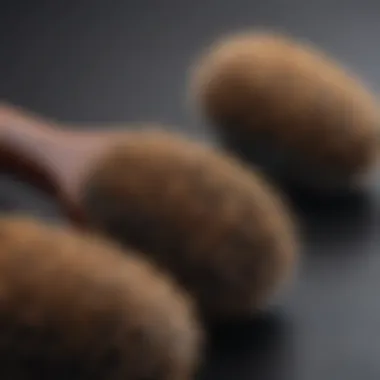Top Hairbrushes for Thick Tangled Hair


Intro
Choosing the right hairbrush is critical for anyone with thick, tangled hair. Hair that is dense and prone to knots needs special care. The right brush can make a significant difference in maintaining hair health and minimizing damage. Several factors come into play when purchasing a hairbrush. You should consider your hair texture, length, and styling preferences.
This guide will explore the essential aspects that make a hairbrush suitable for thick hair. We will discuss various types of brushes, their unique designs, and features that help in detangling effectively. Additionally, recommendations based on individual needs will be provided. Through this exploration, readers will understand the connection between brush quality and hair vitality, leading to more informed choices in their hair care routines.
Understanding Hair Texture
Before diving into the types of hairbrushes available, it's crucial to understand hair texture. Thick hair can vary in strand thickness, curl pattern, and level of porosity. Recognizing these factors aids in selecting the right brush, ensuring it aligns with your specific hair needs.
Types of Thick Hair
- Straight Hair: Might experience less tangling but can still become knotted if neglected.
- Wavy Hair: Has a tendency to tangle due to the natural wave pattern, requiring careful detangling methods.
- Curly Hair: Often difficult to manage due to tight curls, needing a brush that minimizes breakage.
Understanding these types will simplify the selection process for brushes designed to manage knots effectively.
Selecting the Right Brush
When it comes to brushes, not all are created equal. Different designs cater to specific hair types and conditions. Here are some of the popular brush types suitable for thick, tangled hair:
Paddle Brushes
These feature a flat design, ideal for straightening and smoothing out hair. The wide surface creates a smooth finish.
Wide-Tooth Combs
Perfect for detangling wet hair, they prevent breakage and are gentle on curls.
Detangling Brushes
Specifically designed to tackle knots with minimal effort. They often have flexible bristles that bend and move through tangles.
Round Brushes
Useful for blow-drying and creating volume. They can help in styling as well as detangling when used correctly.
Boar Bristle Brushes
Useful in distributing natural oils from the scalp down to the tips, promoting shine and aiding in detangling.
Understanding the function of each brush type can drastically improve your hair care routine.
Features to Look For
Certain features can enhance the detangling experience. Here are a few pivotal aspects to consider:
- Bristle Material: Look for nylon or boar bristles which are known for their detangling abilities.
- Grip and Comfort: A comfortable handle enhances ease of use, especially for thick hair.
- Flexibility: Brushes with flexible bristles or cushioned bases often provide a gentler touch.
- Size: Larger brushes can cover more hair at once and are beneficial for thick hair.
"Selecting the right hairbrush isn't just about removing tangles; it is about maintaining overall hair health and wellness."
Personalized Recommendations
Finding the ideal hairbrush can be a personal journey, as individual hair characteristics play a significant role. For those with coily or extremely curly hair, the TANGLE TEEZER Original may offer the gentleness required for delicate tangles. Alternatively, a paddle brush from the wet brush range could suit those with thick, straight hair looking for a quick smoothing option.
Ultimately, understanding your hair’s unique texture and qualities empowers you to make informed choices about your hairbrush. With the right tools, managing thick, tangled hair can become a more manageable task.
Understanding Thick Tangled Hair
Understanding thick tangled hair is crucial for anyone looking to maintain their strands effectively. This section provides a foundation for comprehending the unique characteristics and challenges that come with thick hair.
Thick hair often requires more thoughtful care than other types. Recognizing its qualities can help in selecting the right hairbrush. Moreover, knowledge of these traits leads to better hair care practices, encouraging healthier and more manageable hair.
Characteristics of Thick Hair
Texture
Texture refers to the individual fibers of the hair. Thick hair typically has a coarser texture, which can significantly affect overall styling. The key characteristic here is the width of each strand. Thicker strands can stand up to more tension when brushing or styling, making them less likely to break. However, this same thickness can also lead to tangling if not properly managed, as the fibers tend to catch on each other.


Porosity
Porosity is about how well hair absorbs and retains moisture. For thick hair, the porosity level varies. High porosity hair absorbs moisture quickly but loses it just as fast, which can create a need for regular hydration treatments. This quality makes it important to choose a brush that can distribute moisture evenly throughout the hair. Low porosity thick hair, on the other hand, may resist moisture, making it appear dull and difficult to style. Understanding porosity is vital when selecting hair care products.
Density
Density refers to how many strands of hair are present on the head. Thick hair usually has a high density, leading to bulkiness. This substantial amount of hair can make styling more complex, as it may require more time and effort to manage. One advantage of high-density hair is its versatility in styling; however, it also has the potential to become tangled more easily.
Common Issues with Tangled Hair
Addressing common issues like breakage, frizz, and difficulty in styling is essential. By understanding these problems, one can make informed decisions regarding the type of hairbrush needed for effective management.
Breakage
Breakage can be a significant concern for those with thick tangled hair. It often arises from improper brushing techniques or the wrong brush type. The key characteristic of breakage is its damage to hair fibers, which leads to uneven lengths and split ends. Using a brush that is gentler and designed for thick hair can reduce the likelihood of breakage significantly.
Frizz
Frizz occurs when hair fibers become raised, leading to a fuzzy appearance. This issue is prevalent among thick hair types since the larger strands can be more susceptible to humidity and moisture loss. While frizz can be frustrating, utilizing a suitable hairbrush can help to smooth out strands and minimize this problem. The unique feature is that a good brush can also help to distribute oils from the scalp throughout the hair, improving overall texture and reducing frizz.
Difficulty in Styling
Many individuals with thick hair encounter difficulty in styling. This issue often stems from the hair’s natural resistance to being shaped or styled. The key characteristic of this struggle is that thick hair can be time-consuming to manage and may not hold styles as well as thinner hair types. Finding the right brush that complements the hair's density and texture is vital. A proper brush can help tame stubborn sections and promote better styling outcomes.
The Role of Hairbrushes in Hair Care
Hairbrushes might seem like simple tools, but they play a crucial role in the maintenance and shaping of hair. Selecting the right hairbrush can affect various aspects of hair health and styling efficiency. For individuals with thick, tangled hair, understanding the nuances of hairbrushes is imperative.
Why the Right Brush Matters
Impact on Hair Health
Using the correct brush directly affects the health of your hair. A good hairbrush minimizes damage caused by daily grooming. Brushes designed for thick hair tend to have features that reduce pull and breakage, ensuring that strands remain intact. Choosing the right brush can mean the difference between healthy hair and excessive split ends. Furthermore, a well-designed brush can help distribute natural oils from the scalp, promoting shine and reducing dryness.
Ease of Detangling
Detangling can be a frustrating task, especially for those with thick hair. The right brush will glide through tangles with minimal effort. Brushes that are wider or feature flexible bristles can effectively work through knots without causing tearing. This ease not only saves time but also enhances the overall grooming experience. A good detangling brush should ideally be able to tackle even the most stubborn knots, providing an experience that is kinder to the hair.
Styling Flexibility
Styling thick hair often requires versatility. A multi-functional brush allows for different techniques, from straightening to curling. Some brushes have designs that cater to both smoothing and volumizing, making them highly sought after. The unique aspect of a flexible brush is its capability to adapt to various styling needs without compromising hair health. Therefore, selecting a brush that offers such versatility can simplify your hair routine.
Types of Hairbrushes
Different types of brushes serve specific purposes and having a range is advantageous for hair care.
Paddle Brushes
Paddle brushes are known for their wide, flat surfaces. These brushes are excellent for detangling due to their large contact area, allowing them to manage thick hair efficiently. The smooth bristles help in distributing oils evenly across the hair, enhancing its health. They are especially beneficial for straight hair types but may struggle with tighter curls, proving less versatile in some cases.
Wide-Tooth Combs
Wide-tooth combs are essential for minimizing breakage during detangling, particularly for thick and textured hair. Their design allows the user to pass through the hair without pulling too hard. This makes them a favored choice for detangling wet hair, as the comb gently works through knots without causing further damage. Utilizing a wide-tooth comb can be a great way to maintain hair integrity while ensuring a smooth and manageable finish.
Round Brushes
Round brushes are used mainly for styling. They help create volume and smoothness, especially when blow-drying. The key feature of a round brush is its ability to shape hair while it dries, providing a more polished look. However, they may require more skill to use effectively, and if used improperly, they can lead to tangling. Their styling potential, though, makes them a valuable tool in achieving salon-quality results at home.
A well-chosen brush not only prevents damage but can also elevate the entire hair care experience.
Key Features to Consider
Choosing the right hairbrush is essential for anyone with thick tangled hair. The right brush features should be carefully evaluated because they can directly affect hair health and manageability. Specifically, paying attention to bristle type and brush shape and size can help minimize damage and improve detangling.
Bristle Type
Nylon bristles


Nylon bristles are popular because they are firm and flexible. This characteristic allows them to glide through thick hair easily, making them effective at detangling. They are also resistant to heat, which can be beneficial if you use heat styling tools. However, one downside is that they may not distribute natural oils as well as other materials. This means you may need additional product to maintain shine and moisture.
Boar bristles
Boar bristles excel in distributing scalp oils, which can lead to a shinier and healthier appearance. They are softer than nylon bristles and are less likely to cause static or frizz. The key disadvantage is that boar bristles may struggle with very thick or curly hair. They work better on finer hair types. Thus, considering your hair type is crucial when deciding if this option fits your needs.
Combination bristles
Combination bristles merge nylon and boar materials. This blend offers the strength needed for detangling while also providing oil distribution. It is a versatile choice, suitable for various hair types, especially thick and tangled hair. However, users should note that the mixed bristle types may require more care to maintain, ensuring that both types are functioning well.
Brush Shape and Size
Dimensions for thick hair
Dimensions of a hairbrush are vital for optimal performance. Wider brushes can cover more area, making detangling faster and more efficient. Thick hair often requires a brush with larger dimensions to accommodate its volume. However, some people choose narrower options for precision styling. Hence, understanding personal preference is important in this consideration.
Overall design considerations
The design of a brush can affect its usability. Ergonomic handles can provide comfort during use, especially for thick, tangled hair which requires more effort to manage. Lightweight materials can also reduce fatigue over time. While choosing design features, make sure they align with your hair care routine and ergonomics for the best experience.
Top Recommendations for Thick Tangled Hair
Selecting the right hairbrush can transform the experience of managing thick, tangled hair. This section offers insightful recommendations tailored to the unique needs associated with such hair types. Understanding the importance of brush selection is crucial. The right brush can streamline detangling efforts, minimize breakage, and promote overall hair health. Furthermore, specific recommendations can serve as a guide to match individual needs, enhancing both practicality and outcomes.
Best Paddle Brushes
Features and Benefits
When it comes to features and benefits, paddle brushes are often favored for their broad, flat surfaces. They efficiently cover larger sections of hair, which can significantly reduce detangling time. The wide base allows for easy manipulation of thick hair without excessive pulling. A key characteristic of these brushes is their bristle arrangement, designed to glide smoothly through strands.
Advantages:
- Time efficiency: Deters knots and tangles quickly.
- Versatility: Works well for styling and smoothing.
This makes paddle brushes a beneficial choice, especially when aiming to minimize damage and frizz during the detangling process. Together with their ability to enhance styling versatility, they are essential tools for individuals with thick tangled hair.
Brand Recommendations
In the realm of paddle brushes, brands like Tangle Teezer and Mason Pearson stand out. Tangle Teezer is known for its innovative design that promotes effective detangling without tugging. Their unique feature is the flexible bristles that can gently glide through hair, preventing breakage, which is vital for thick, tangled hair.
Mason Pearson offers a traditional brush that combines boar bristles with nylon ones for enhanced detangling. This dual approach permits effective smoothing while nourishing the hair.
Each of these brands has proven popular due to their quality and effectiveness, making them viable options worth considering.
Best Wide-Tooth Combs
Implementing Effective Detangling
Wide-tooth combs have a significant role in effective detangling. Their spacious teeth allow for easy separation of strands, thus minimizing pulling. Starting at the ends and working upwards is an essential technique for preserving hair integrity. A key characteristic of wide-tooth combs is their ability to manage wet hair, as they prevent unnecessary breakage, which can occur with tighter bristles.
Benefits:
- Gentle detangling: Offers a thorough yet non-invasive approach.
- Suitable for various hair types: Particularly effective for textured and thick hair.
This makes wide-tooth combs a beneficial and necessary addition to any haircare routine, especially for those facing tangles.
Recommended Products
For wide-tooth combs, options such as the Goody Double Tooth Comb and the Wet Brush Original Detangler are available recommendations. The Goody Double Tooth Comb is specifically made for thick hair, with its unique design that promotes an effortless glide through tangles. In contrast, the Wet Brush Original Detangler is excellent for both dry and wet hair, using adaptive bristles that adjust to the texture.
Both products are sound choices, offering distinct advantages that cater to detangling needs effectively. Their unique features foster a comfortable brushing experience that minimizes damage to thick hair.
Brushing Techniques for Thick Hair
Effective brushing techniques are crucial for maintaining healthy hair, especially for those with thick and tangled locks. Proper brushing methods can reduce damage, facilitate easier detangling, and promote overall hair health. This section discusses the best techniques for brushing thick hair, focusing on how to properly detangle and minimize breakage. Understanding these techniques will empower you to care for your hair more effectively.
Proper Detangling Methods


Detangling should be done gently and systematically to avoid unnecessary stress on the hair. Two key methods are sectioning hair and starting from the ends. These methods ensure that your hair detangling process is efficient and gentle.
Sectioning Hair
Sectioning hair involves dividing your mane into manageable parts. This method allows for more controlled brushing, reducing the risk of pulling and breaking hair. The main characteristic of sectioning is that it enables you to focus on one area at a time. This method is popular for a number of reasons:
- Prevents Overwhelm: Tackling smaller sections makes the process less daunting.
- Reduces Breakage: Less pulling means a lower chance of causing damage.
- Increases Precision: You can target knots and tangles directly without affecting the whole head of hair.
The unique feature of sectioning is its practicality. Hair is easier to manage when it's divided. However, if not done methodically, sectioning can lead to uneven treatment of hair areas, resulting in partial tangles remaining.
Starting from the Ends
Starting from the ends of the hair is an essential technique that minimizes the risk of breakage. When you brush from the ends and work your way up, you gently remove knots without tugging at the roots. This is particularly beneficial for thick hair, which may experience significant resistance during brushing.
The key characteristic of this method is its gentleness. It prevents unnecessary strain on the hair follicles and can be considered a preferred choice for many.
- Reduces Pain: Because you are avoiding tugging at the scalp, this method is more comfortable.
- Allows for Better Control: You can feel where the knots are and manage them effectively.
A unique feature of starting from the ends is its effectiveness for all hair types, though it is especially useful for thick and tangled hair. However, some individuals may find this technique time-consuming, as it requires patience.
How to Minimize Breakage
Minimizing hair breakage is another vital aspect of maintaining thick locks. Proper techniques will lead to thicker hair health, ensuring that the brushing process does not contribute to further tangles.
Using Proper Tension
Using the right amount of tension when brushing can significantly affect hair health. This method focuses on how tightly or loosely you handle the hair while brushing. The main characteristic of using proper tension is balance; too much tension will lead to breakage, while too little can be ineffective at detangling.
- Saves Time: Proper tension allows for quicker detangling without causing damage.
- Prevents Frizz: Less breakage means you also reduce the occurrence of frizz.
A unique feature is that adjusting your grip can allow you to control the brushing pressure. This technique offers a tailored experience for individuals with unique hair properties. However, it can take practice to gauge the right tension.
Choosing the Right Time to Brush
Timing your brushing sessions can have profound effects on hair integrity. Brushing when hair is wet versus dry leads to different results. Wet hair is more susceptible to damage due to its vulnerable state, while dry hair offers resilience against breakage.
The key consideration in this method is understanding your hair type and condition. Brushing at the right time can prevent unnecessary strain on the hair.
- Convenience: Brushing dry hair often aligns better with daily routines.
- Healthier Hair: Brushing when hair is dry can minimize breakage.
A unique feature of this technique is its adaptability; depending on individual needs, the timing can be adjusted. However, it requires awareness of your hair's current state to achieve the best results.
"Time and method matter. How you brush can significantly affect the quality of your hair."
By employing effective brushing techniques, you cater specifically to the needs of thick tangled hair. Each step from sectioning hair to choosing the right time to brush contributes holistically to hair health, preventing damage and maintaining aesthetic appeal.
Maintaining Your Hairbrush
Maintaining your hairbrush is crucial for ensuring your hair health and optimizing your styling experience. A well-cared-for brush not only performs better but also contributes to the overall health of your hair. When hairbrushes are kept clean, they help minimize breakage and entanglement. Regular care can extend the lifespan of the brush, making it a smart investment.
Cleaning Techniques
Removing hair strands
Removing hair strands from your brush is a fundamental step in its maintenance. Hair strands accumulate quickly, and if they are not cleared regularly, they can impede the brushing process. One key characteristic of this practice is that it prevents tugging on the hair during brushing. This can lead to less damage and breakage over time.
Using a simple tool like a comb or a pair of scissors can help you effectively remove trapped hair. One significant advantage of this technique is that it ensures your brush remains effective each time you use it.
Sanitizing materials
Sanitizing materials is another essential aspect of hairbrush care. Keeping your brush free from germs and bacteria contributes to better scalp health. A clean brush can prevent the transfer of oils and residues that accumulate on the bristles. Regularly wiping down the handle and bristles with gentle disinfectant or soap and water is a beneficial practice.
Using the right sanitizing methods can prolong the life of your brush and support a healthier scalp environment, particularly for users with sensitive skin.
Storage Recommendations
Keeping bristles intact
Keeping bristles intact is vital for maintaining the effectiveness of your hairbrush. Bristles that are bent or damaged will not detangle hair properly, resulting in a frustrating experience. Proper storage, such as avoiding placing heavy objects on top of the brush, is essential. Doing so preserves the shape and function of the bristles, which are designed for achieving smooth results. One advantage of this care is that it sustains the efficiency of your tool without needing frequent replacements.
Organizing styling tools
Organizing styling tools is another important aspect of maintaining your hairbrush. Keeping your hairbrush stored in a designated area reduces the risk of damage from being tossed around or tangled with other tools. Utilizing a specific drawer or caddy can help streamline your hair care routine. This organization ensures that each tool is easily accessible while minimizing wear and tear.
In summary, effective maintenance of your hairbrush combines regular cleaning with proper storage techniques. This approach enhances hair health and allows for efficient styling, making a noticeable difference in how thick, tangled hair is managed.















